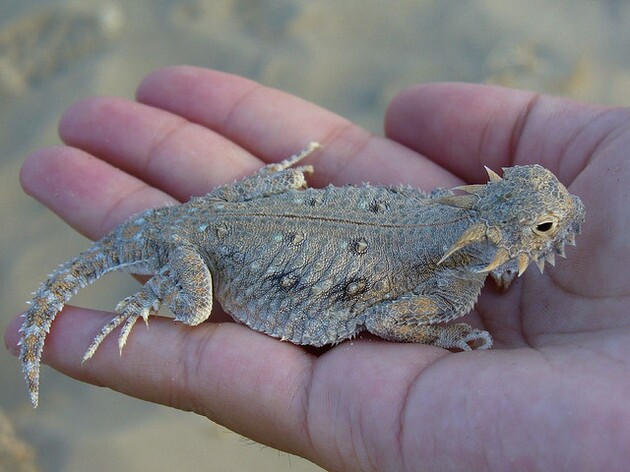Rare Desert Lizard May Get State Protection

A small and secretive horned lizard may warrant protection under the state law, according to the California Department of Fish and Wildlife. The agency is recommending that the state's Fish and Game Commission consider listing the flat-tailed horned lizard as Endangered under the California Endangered Species Act.
The three-and-a-half inch lizard, known to scientists as Phrynosoma mccallii, lives on sandy and gravelly soils in the California portion of the Sonoran Desert in Riverside, Imperial, and San Diego counties, as well as Yuma County in Arizona and portions of Northern Mexico. Wildlife protection activists have been trying to get the flat-tailed horned lizard protected under state and federal endangered species laws for nearly three decades.
The recommendation by the Department of Fish and Wildlife comes as a response to a petition filed in June by the Center For Biological Diversity, which says that decades without protection have devastated populations of the ant-eating reptile.
The California Fish and Game Commission is expected to discuss whether to list the flat-tail at its regular meeting in February.
"The Department of Fish and Wildlife has recognized that all the data point to this charismatic little lizard's demise in our desert," said Ileene Anderson of Center for Biological Diversity. "The fate of the flat-tail is now in the hands of the commission. State protection could be the difference between life and death for these unique creatures."
The flat-tail is uniquely adapted to life on open desert soils: it will run a distance from potential threats and then freeze in position, relying on its superb camouflage for protection. As a result of this behavioral strategy of freezing in place, the flat-tail is often killed by vehicles traveling over desert soils. Invasive plants such as Sahara mustard also pose a threat to flat-tails when the plants fill in the bare soil -- essential habitat -- between desert shrubs, and of course development of the desert for residential or commercial use, or utility-scale solar projects, also displaces the lizard. The vast majority of flat-tail habitat that once existed in the Coachella Valley has been destroyed, with only a bit remaining near the Whitewater River and the Coachella Valley Preserve. Just a few Coachella flat-tails remain.
Meanwhile, Imperial County has been a bit of a stronghold for the flat-tailed horned lizard, but its numbers are declining even there, especially with that county's new surge of solar and wind development. The Bureau of Land Management recently reopened 43,000 acres of flat-tail habitat in the Algodones Dunes to off-road vehicle use.
Despite decades of decline, the U.S Fish and Wildlife Service has repeatedly declined to give the flat-tailed horned lizard protection under the U.S. Endangered Species Act, withdrawing its own proposals to list the lizard as Threatened three times since 1997.
Protection under the California Endangered Species Act won't protect lizards in Arizona and Mexico, but it would offer some relief to the lizards in the Salton Basin.
"Flat-tail horned lizard populations have been declining for decades," said Anderson. "And we've come to a critical point where we need to protect this species now to save it from extinction."